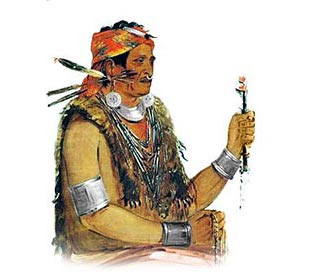History of Maryland Indians - The French Indian Wars
The French and Indian Wars (1688 - 1763) was a generic names for a series of wars, battles and conflicts involving the French colonies in Canada and Louisiana and the 13 British colonies, which included Maryland, consisting of King William's War (1688-1699), Queen Anne's War (1702-1713), King George's War (1744 - 1748) and the French and Indian War aka the Seven Years War (1754-1763). Various Maryland Indian tribes were allied to the French and British colonies during the French Indian Wars which raged for nearly 75 years. Fast Facts about the History of Maryland Indians
The climate, land, history, environment and natural resources that were available to the indigenous Indian tribes in Maryland resulted in the adoption of the Northeast Woodlands culture - Name of State: Maryland
- Meaning of State name: King Charles I of England specified that the name for the new colony was to be called Maryland in honor of his wife, Queen Henrietta Maria
- Geography, Environment and Characteristics of the State of Maryland: Coastal plains, peidmont plateau, and the Blue Ridge, separated by the Chesapeake Bay
- Culture adopted by Maryland Indians: Northeast Woodlands Cultural Group
- Languages: Iroquoian and Algonquian
- Way of Life (Lifestyle): Hunter-gatherers, farmers, fishers, trappers
- Types of housing, homes or shelters: Chickees, Wigwams (aka Birchbark houses) and Longhouses
History Timeline of the Maryland Indians - 10,000 B.C.: Paleo-Indian Era (Stone Age culture) the earliest human inhabitants of America who lived in caves and were Nomadic hunters of large game including the Great Mammoth and giant bison.
- 7500 BC: Eastern Woodland Culture of Fisher Hunters begins. Permanent houses and farming
- 7000 BC: Archaic Period in which people built basic shelters and made stone weapons and stone tools
- 1000 AD: Woodland Period including the Hopewell cultures established along rivers in the Northeastern and Midwestern United States which included trade exchange systems and burial systems
- 1608: Captain John Smith (1580-1631) explores the Chesapeake Bay - refer to Powhatan
- 1675: 1675-l676 Bacon's Rebellion and the Declaration of the People. War with Susquehannocks in Maryland
- 1688: 1688 - 1763 The French and Indian Wars between France and Great Britain for lands in North America consisting of King William's War (1688-1699), Queen Anne's War (1702-1713), King George's War (1744 - 1748) and the French and Indian War aka the Seven Years War (1754-1763)
- 1688: (1688-1699) King William's War (part of the French and Indian Wars) between France and the Wabanaki Confederacy and England and the Iroquois Confederacy. Peace Treaty made at Pemaquid. August 11,1693. and was ratified on Jan. 7. 1699
- 1754: (1754-1763) French and Indian War known in the US as the Seven Years War, (part of the French and Indian Wars) between the colonies of France allied with the Wabanaki Confederacy, Algonquin tribes, Abenaki, Míkmaq, Mohawk, Lenape, Ojibwa, Ottawa, Shawnee, Wyandot and Great Britain allied with the Iroquois Confederacy, Onondaga, Oneida, Seneca, Tuscarora, Mohawk, Cayuga, Catawba and Cherokee tribes
- 1763: Treaty of Paris
- 1775: 1775 - 1783 - The American Revolution.
- 1776: July 4, 1776 - United States Declaration of Independence
- 1803: The United States bought the Louisiana Territory from France for 15 million dollars for the land
- 1812: 1812 - 1815: The War of 1812 between U.S. and Great Britain, ended in a stalemate but confirmed America's Independence
- 1830: Indian Removal Act
- 1832: Department of Indian Affairs established
- 1861: 1861 - 1865: The American Civil War.
- 1862: U.S. Congress passes Homestead Act opening the Great Plains to settlers
- 1865: The surrender of Robert E. Lee on April 9 1865 signalled the end of the Confederacy
- 1887: Dawes General Allotment Act passed by Congress leads to the break up of the large Indian Reservations and the sale of Indian lands to white settlers
- 1969: All Indians declared citizens of U.S.
- 1979: American Indian Religious Freedom Act was passed
|
